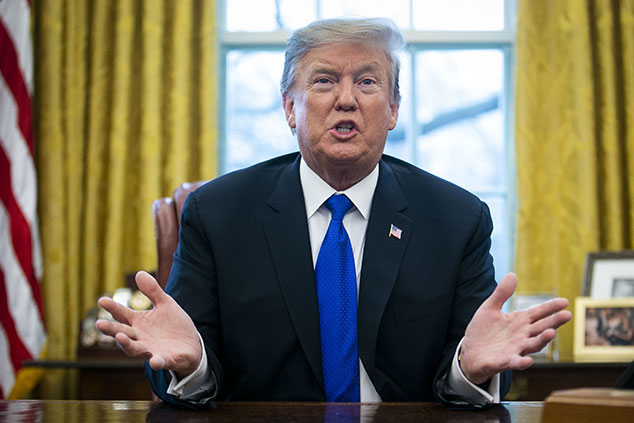
This article is taken from our FREE daily investment email Money Morning.
Every day, MoneyWeek’s executive editor John Stepek and guest contributors explain how current economic and political developments are affecting the markets and your wealth, and give you pointers on how you can profit.
Chinese stocks are off to the races this morning.
It’s all thanks to social media site Twitter. Or rather, it’s all thanks to one specific Tweeter on Twitter.
This morning, US president Donald Trump announced that he’s not going to raise US tariffs on Chinese goods on 1 March, as previously planned.
Is the trade war de-escalating? Is it a classic Trump tweet, soon to be reversed? And what does it mean for your money either way?
What’s in the US-China trade deal?
The current round of US-China trade talks was meant to end on Friday. But the Chinese representative – vice premier Liu He – stayed in Washington for the weekend. And it seems to have paid off.
“The US has made substantial progress in our trade talks with China on important structural issues including intellectual property protection, technology transfer, agriculture, services, currency, and many other issues.
“As a result of these very productive talks, I will be delaying the US increase in tariffs now scheduled for March 1.”
That’s what Donald Trump tweeted this morning.
Meanwhile, “we believe it is very likely that it will happen and we hope that we will have a deal. The Chinese side is ready to make our uttermost effort,” was the message from the Chinese delegation at a press conference this morning.
Now the hope is that Trump and Chinese president Xi Jinping will meet up in Trump’s resort in Florida at some point in the near-ish future, and finalise a deal.
So there you go. Everyone’s happy. Chinese stocks surged (jumping about 5% or so) while the currency, the yuan, strengthened too. And other Asian stockmarkets gained too – Japanese stocks climbed, for example.
So amid all the good cheer, what has actually been agreed now? The short answer is that we don’t know. But it is likely to focus on a few areas.
First, there’s the currency. The US wants China to avoid artificially weakening its currency in order to offset any US tariffs. The US has long had vague complaints that China’s currency is too weak, and that the country has used it as a trade weapon.
This may or may not be fair enough (China does have to be careful – if it weakens its currency too much then it’ll spark drastic capital flight). But it’s a tricky one to enforce one way or another.
Secondly, there’s the question of the approach to technology. Again, that’s one of those things which is easy to agree about on paper, but harder to monitor and enforce in reality.
Finally, there’s the question of China agreeing to buy more stuff from the US (soybeans are the most regularly cited at the moment). This really isn’t that significant for anyone but the individual lobby groups who’ll benefit – mainly farmers and, possibly, manufacturers.
We are likely to get a deal, because Trump wants to win an election
In all, Trump probably needs a trade deal. There’s a US election next year. Everyone is talking about recession right now, and if there’s one thing that an incumbent president really wants to avoid, it’s a recession during an election. Incumbents do not win elections against a backdrop of recession.
This is a key driver of “the presidential cycle”. This is the observed phenomenon that stockmarkets tend to do well during the third year of a president’s term, precisely because presidents do their best to get re-elected (or to get their parties re-elected).
Clearly, there is only a limited amount of data to go on here so this is hardly a reliable statistic. But it certainly makes intuitive sense. So the path of least resistance (with a few ups and downs along the way) is likely to be a trade deal, with the hope that this will revitalise “animal spirits”, and put Trump in a good position to win the 2020 election.
This is also one reason why he’s so keen to “build the wall”, incidentally. There’s the point that it’s popular with his voters, but there’s also the point that if you spend a load of money on building a great big wall, then that will help to boost GDP, one way or another.
Given that the Democrats look increasingly likely to run on a big-spending agenda too – and that the Federal Reserve has thrown in the towel – it seems that no one in the US political sphere is currently interested in keeping an eye on the purse strings.
In the shorter run – as I’ve been saying for a while, I still think the next crisis will be inflationary rather than deflationary. A president (and an opposition), hell bent on pumping money into an already tight US economy, does represent exactly the sort of scenario you’d need to get inflation.
That in turn implies downside for bonds, some upside for stocks, and good news for both precious and base metals.
In the longer run, this move in the US towards the government spending more money, while keeping taxes roughly where they are, is likely to help to undermine the dollar’s status as the global reserve currency. That’s something I’ll be writing about in the next issue of MoneyWeek, out on Friday – subscribe now to make sure you get hold of that one.